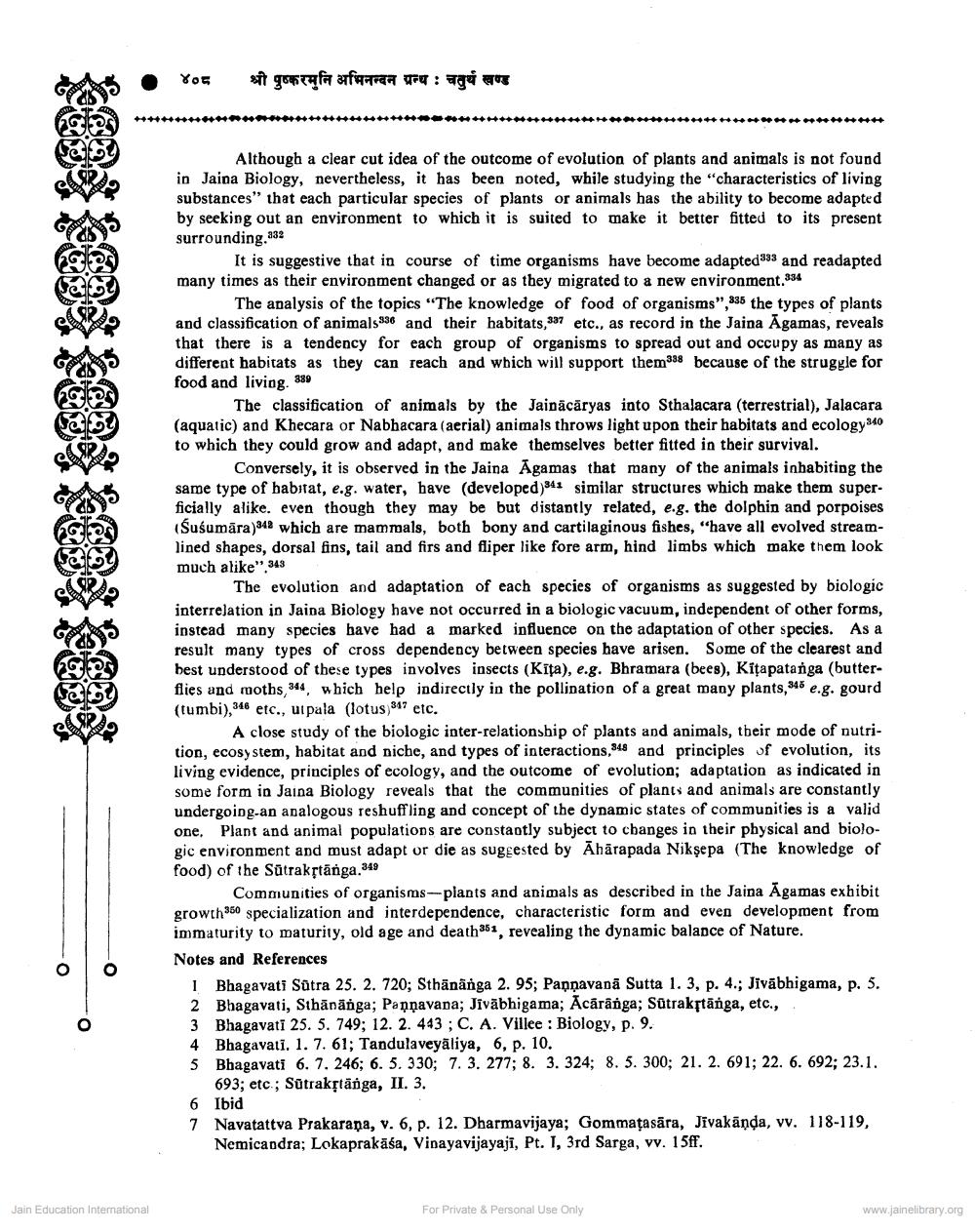________________
-O
O
O
Jain Education International
૪૦૬
श्री पुष्करमुनि अभिनन्दन ग्रन्थ : चतुर्थ खण्ड
Although a clear cut idea of the outcome of evolution of plants and animals is not found in Jaina Biology, nevertheless, it has been noted, while studying the "characteristics of living substances" that each particular species of plants or animals has the ability to become adapted by seeking out an environment to which it is suited to make it better fitted to its present surrounding.332
It is suggestive that in course of time organisms have become adapted 333 and readapted many times as their environment changed or as they migrated to a new environment.334
The analysis of the topics "The knowledge of food of organisms", 335 the types of plants and classification of animals 336 and their habitats,337 etc., as record in the Jaina Agamas, reveals that there is a tendency for each group of organisms to spread out and occupy as many as different habitats as they can reach and which will support them338 because of the struggle for food and living.
389
The classification of animals by the Jainācāryas into Sthalacara (terrestrial), Jalacara (aquatic) and Khecara or Nabhacara (aerial) animals throws light upon their habitats and ecology 340 to which they could grow and adapt, and make themselves better fitted in their survival.
Conversely, it is observed in the Jaina Agamas that many of the animals inhabiting the same type of habitat, e.g. water, have (developed) similar structures which make them superficially alike. even though they may be but distantly related, e.g. the dolphin and porpoises (Suśumāra)342 which are mammals, both bony and cartilaginous fishes, "have all evolved streamlined shapes, dorsal fins, tail and firs and fliper like fore arm, hind limbs which make them look much alike" 343
The evolution and adaptation of each species of organisms as suggested by biologic interrelation in Jaina Biology have not occurred in a biologic vacuum, independent of other forms, instead many species have had a marked influence on the adaptation of other species. As a result many types of cross dependency between species have arisen. Some of the clearest and best understood of these types involves insects (Kīta), e.g. Bhramara (bees), Kitapatanga (butterflies and moths, 344, which help indirectly in the pollination of a great many plants,345 e.g. gourd (tumbi),346 etc., utpala (lotus)347 etc.
A close study of the biologic inter-relationship of plants and animals, their mode of nutrition, ecosystem, habitat and niche, and types of interactions,348 and principles of evolution, its living evidence, principles of ecology, and the outcome of evolution; adaptation as indicated in some form in Jaina Biology reveals that the communities of plants and animals are constantly undergoing-an analogous reshuffling and concept of the dynamic states of communities is a valid one. Plant and animal populations are constantly subject to changes in their physical and biologic environment and must adapt or die as suggested by Ahārapada Nikṣepa (The knowledge of food) of the Sütrakṛtānga.349
Communities of organisms-plants and animals as described in the Jaina Agamas exhibit growth 350 specialization and interdependence, characteristic form and even development from immaturity to maturity, old age and death 351, revealing the dynamic balance of Nature. Notes and References
I Bhagavati Sutra 25. 2. 720; Sthānanga 2. 95; Pappavana Sutta 1. 3, p. 4.; Jivabhigama, p. 5. 2 Bhagavati, Sthanänga; Pappavana; Jivabhigama; Acaranga; Sütrakṛtānga, etc.,
3 Bhagavati 25. 5. 749; 12. 2. 443; C. A. Villee: Biology, p. 9.
4 Bhagavati. 1. 7. 61; Tandulaveyäliya, 6, p. 10.
5 Bhagavati 6. 7. 246; 6. 5. 330; 7. 3. 277; 8. 3. 324; 8. 5. 300; 21. 2. 691; 22. 6. 692; 23.1. 693; etc.; Sūtrakṛtānga, II. 3.
6 Ibid
7 Navatattva Prakaraņa, v. 6, p. 12. Dharmavijaya; Gommaṭasāra, Jivakāṇḍa, vv. 118-119, Nemicandra; Lokaprakāśa, Vinayavijayaji, Pt. I, 3rd Sarga, vv. 15ff.
For Private & Personal Use Only
www.jainelibrary.org




